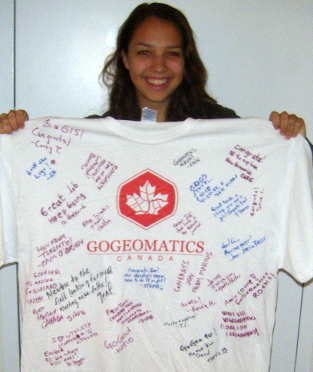
GoGeomatics: Welcome to the GoGeomatics Canada community. To begin, can you tell us where you are from and where you have lived throughout your GIS career?
Sheila Churchill: I live in Vancouver, British Columbia, I have lived here most of my life.
GoGeomatics: How did you get your GIS education? 
Sheila Churchill: After working as a geologist for many years, I decided I needed a change. I enjoying working with computers and also teaching, so after some research I decided GIS would be something I would like to do. I found the BCIT GIS program and enrolled.
GoGeomatics: What was your first job in GIS like?
Sheila Churchill: My first GIS job was working for a company creating learning modules to teach their employees the QuickMap software. Soon after that I was hired by BCIT to be an assistant instructor in the BCIT GIS program.
GoGeomatics: How would you describe your GIS career thus far? How have you got to be where you are now as a GIS instructor?
Sheila Churchill: The exciting thing about GIS is that it is always changing. Even though I have been teaching at BCIT for many years, I am never teaching the same course over and over again. I have to constantly keep updating my knowledge, through industry courses, conferences, and by obtaining a Master’s Degree in GIS from City University in London, England.
GoGeomatics: How have you seen GIS evolve throughout your time as a GIS Instructor? How have you adapted your teachings to coincide with this?
Sheila Churchill: GIS has evolved from standalone applications using command line input on UNIX workstations to being embedded in applications running on tablets and smartphones. Constant updating and changing of our course material and coursed taught keeps us on top of these changes. As well, our hardware and software is continually being updated. In the 1980s and 1990s most of the work was digitizing paper maps and compiling base data. Today much of that work is done, and more data is provided by government agencies. Our work now is integrating different data sources and doing interesting analysis on the desktop and web.
GoGeomatics: What makes an excellent GIS program in your opinion?
Sheila Churchill: An excellent GIS program is one that teaches students the skills that employers want. The program has to have the latest technology available to students, but it must also teach students problem solving and communication skills. The program must also have strong ties to the GIS industry, to expose students right away to the environment they will be working in. Finally, the GIS program must be flexible in how the courses are delivered, so that full time, part time, distance and face to face students can all obtain a high quality education.
GoGeomatics: How do you, as GIS Faculty, make sure that what you are teaching and imparting to new GIS students is giving them the skills and the problem solving they will need for the work force?
Sheila Churchill: We meet with our Program Advisory Committee twice a year to discuss the program and the graduates we are producing. The Program Advisory Committee is made up of members of the GIS industry from various backgrounds. They give us valuable input on what is working in our program and what needs to be changed or updated to reflect industry needs.
GoGeomatics: In terms of GIS concepts, what is the most difficult item for you to teach?
Sheila Churchill: It really varies from student to student and course to course. One concept that many students initially have difficulty with is the importance of knowing what projection your data is in, and the difference between a projection and a datum. They often have to experience having data they cannot use because they didn’t understand that the data was in a different projection than they thought.
GoGeomatics: What are some real examples of what you are teaching that achieves this? Do you have any assignments you could share with GoGeomatics?
Sheila Churchill: One of my favorite assignments is one where I give the students a data set with basic metadata, and tell them what I want as a deliverable. The student must investigate the data, figure out what they need to do to the data to produce the deliverables and also figure out what tools are available to them and how to use those tools. Problem solving skills are paramount in this assignment!
GoGeomatics: What does the British Columbia Institute of Technology look for in a prospective student?
Sheila Churchill: Our students must have either a Bachelor’s Degree, a Diploma of Technology or an Associate Degree. We take students from a variety of educational backgrounds, but we do want students who have experience working with computers, and preferably ones who have done some computer programming.
GoGeomatics: Do you have any student portfolios that you would like to share with us? Some that might give other prospective students an idea of what to expect if they were to come to study with you?
Sheila Churchill: Sorry, I would have to get student permission to release them, and at this time we are just starting with a new group of students.
GoGeomatics: What makes your program stand out from all the other programs out there? Why should someone go to the British Columbia Institute of Technology?
Sheila Churchill: Strong ties to industry, up to date technology, a large amount of hands on practical exercises combined with theory. As well as extensive GIS, Database and Mapping applications we also focus on programming skills and web applications. We also insure that students work closely with industry sponsors for student projects and practica.
GoGeomatics: Is there anything about British Columbia and the location of your campus that entices prospective students?
Sheila Churchill: The BCIT Campus is located in Burnaby, British Columbia, which is a suburb of Vancouver. Vancouver has repeatedly been voted one of the best places in the world to live. Lots of recreational activities are available, luckily the weather in the winter months makes sure students focus on their studies! As well, the GIS industry in the Vancouver area is thriving.
GoGeomatics: What are the job prospects like for graduates of your program?
Sheila Churchill: A recent survey of graduates of our program showed that over 80% of our graduates obtained a job in the GIS industry within six months of graduation. Job prospects are very good, however a recent graduate may need to be flexible about relocating if it is their first job, as there is a lot of competition for jobs in Vancouver.
Thank you taking the time to talk to GoGeomatics Canada and showing us what your Advanced Diploma program at British Columbia Institute of Technology has to offer for GIS students.





Be the first to comment